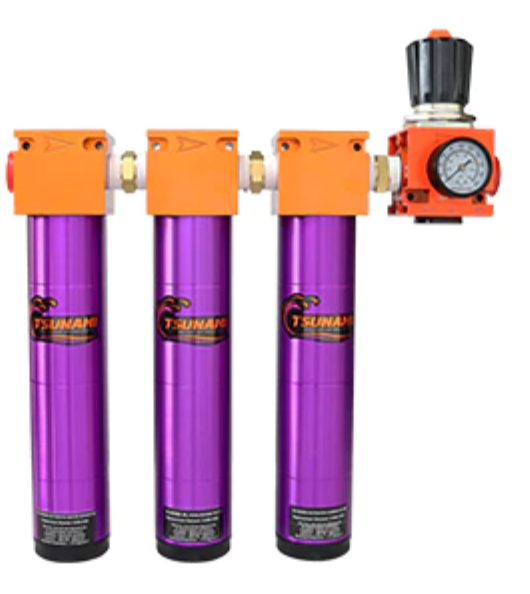In an air system, pneumatic tools and machinery rely on clean, dry air for optimal performance and efficiency. A shop's productivity may be compromised if unfiltered or poorly filtered air is flowing through the tools or equipment. This can result in wear and damage to tools and equipment and lead to an inefficient work place.
In some industries, having compressed air free of dust, water, oil, and other particulates is extremely important. To achieve perfectly dry air, the combination of a high quality air filter and an efficient air dryer is crucial. These components work together to ensure the air supply remains pure and meets regulations.
To determine the best air treatment setup for your system, it's important to know the difference between compressed air filters and dryers, as well as which setup is right for you.
Article contents:
- The Difference Between Air Filters and Air Dryers
- What Compressed Air Filters Remove
- Types of Air Filters and How They Work
- What Air Dryers Remove
- Types of Air Dryers and What They Do
- Choosing the Right Setup for Your System
What is the Difference Between Air Filters and Air Dryers?
Compressed air filters and air dryers work together to create unrivaled dry air, but what they accomplish individually is different.
Compressed air filters improve the quality of the compressed air by removing particles, water, moisture, oil and oil vapor, and other contaminants from the air.
Compressed air dryers have the primary purpose of removing moisture from compressed air. If the moisture (or humidity) is not removed, it can cause issues like corrosion and compromised performance of equipment.
What Do Compressed Air Filters Do?
Compressed air filters play a critical role in an air system by removing various contaminants and pollutants from compressed air before it goes into pneumatic tools, machinery, or other applications. This includes the removal of particles, water, moisture, oil and oil vapor, odor and vapor, and bacteria.
The type of individual filter or filter package you use determines the contaminants that are removed.
For some applications, an air filter package is enough to provide the recommended air cleanliness for that tool or process. Depending on the air standard requirements, an air dryer may not be required.
The air filtration process can vary, but in essence, air filters work by capturing or absorbing contaminants as the air passes through each layer of the filter.
Different Types of Air Filters and How They Work
There are three types of filters: water separators, oil coalescing, and activated carbon. Each filter is created to target specific contaminates ensuring each particular contaminate is fully pulled out of the air flow to give you the purest, cleanest, air for your application.
Microns are used to measure the size of particles that pass through the air. One micron is equal to one millionth of a meter. The filters are pulling out contaminates that are so small they can't be seen by the human eye.
All three filters work the same way; they run well on their own with an air supply, but the more filters added to the process, the dryer and purer air you're going to get because of the amount of layers the particles go through.
How Do Water Separators Work?
 A water separator is a specialized filter that removes water and moisture from a compressed air system to keep the air dry and free from excess moisture. While water separators remove the bulk of water, they also pull out oil and large particulates down to 10 microns.
A water separator is a specialized filter that removes water and moisture from a compressed air system to keep the air dry and free from excess moisture. While water separators remove the bulk of water, they also pull out oil and large particulates down to 10 microns.
A water separator can remove water at a rate of one quart per minute. This is essential, as water can lead to corrosion and other equipment damage. Water separators work in the following way:
- Air enters the filter, it goes through a small diameter tube causing an increase in speed.
- The air reaches the bottom of the inner tube and is then redirected upward through the outer tube where gravity and reduced speed capture large liquid particles.
- The speed increases again as air is forced through small orifice baffles before entering the stainless steel mesh element.
- Any remaining liquids are captured using centrifugal force before the air exits the filter.
- Liquids are automatically ejected through the drain ensuring the filter’s continued efficiency.
How Do Oil Coalescing Filters Work?
 Oil coalescing filters are designed to remove oil, oil vapors, aerosols and fine particulates down to .01 microns. Here’s how they work:
Oil coalescing filters are designed to remove oil, oil vapors, aerosols and fine particulates down to .01 microns. Here’s how they work:
- Air flows through the filter and passes through the element, moving from the center to the outside.
- As the air travels through the fibrous layers, oil aerosols are captured.
- The non-wicking outer layer separates the bulk liquids from the surrounding air stream.
- Gravity slows the bulk liquids to drip into the drain sump off the filter where they are expelled.
How Do Activated Carbon Filters Work?
An activated carbon filter is highly effective in removing certain gases, odors, and VOCs from the air. The carbon removes oil vapors and eliminate odors (and even tastes) from the air. Here's how it works:
- Air enters the filter and passes through the element from the outside to the center.
- As the air travels through the activated carbon layers, oil vapors are captured and held through the process of adsorption.
- No liquids should be present at this stage, so there is no drain.
Compressed Air Filter Solutions
With the help of an air flow connection, compressed air filters efficiently extract contaminants. While accomplished through different processes, each filter removes specific contaminants to provide clean air.
For applications requiring dry air (air without humidity), an air dryer is required.
Types of Air Dryers and What They Do
Compressed air dryers are vastly different than air filters. They are typically bulkier, heavier, and have one main filter function: to remove water vapor (humidity) from compressed air.
Generally speaking, air dryers are built to accomplish this in one of four ways:
- Membrane: These dryers use a membrane to separate water from vapor. The membrane only allows the water to pass through, leaving dry air on the other side.
- Deliquescent: A chemical desiccant is used to remove moisture from the compressed air.
- Refrigeration: These dryers use a refrigeration system to cool the compressed air, causing water vapor to condense to a liquid form. The liquid is then removed from the air stream, leaving behind dry compressed air.
- Desiccant: Materials called desiccants, like activated alumina or silica gel, adsorb moisture from the compressed air and hold the water vapor.
If the goal is to remove or reduce humidity levels in your compressed air system, a compressed air dryer is the perfect solution. By incorporating a compressed air dryer, you will be able to meet or exceed air quality requirements for your tools, equipment, or applications.
Compressed Air Dryer Solutions
The purpose of air dryers is to eliminate all moisture and humidity from compressed air to ensure the best air quality for any application. Removing moisture extends the life of tools and equipment, and produces dry air when paired with a pre-filtration system.
Choosing the Right Setup for Your System
A compressed air filter’s primary purpose is to remove contaminants such as dust, water, oil, and other particulates. This leads to an efficiently running system, equipment that lasts, and good air quality.
Compressed air dryers also play a crucial role in compressed air systems, but their main function is more linear. Their purpose is to remove humidity from compressed air systems. This leads to better productivity, reduces maintenance costs, and improves overall quality.
Do I Need Clean Dry Air?
The choice is yours when deciding if an air filter or an air dryer is the right solution for your compressed air system. Both offer effective ways to filter and dry compressed air - but a combination of both ensures the cleanest, driest air is being used for your applications.
Thank you to our partners at Tsunami for the information for this blog. For more information, please visit TotalFinishingSUPPLIES.com.
To purchase a Tsunami filtration package, please click here.


